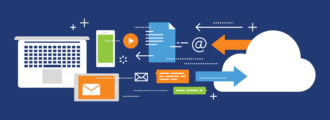Considering a Move to the Cloud?
Industry news outlets, conferences, and social media have all discussed cloud services in-depth, but it can be easy to become overwhelmed in all that noise. That’s why we created this primer of what you need to know to begin analyzing whether the cloud is right for you. There seem to be three main benefits that are always mentioned when making the case for the cloud: cost, rapid deployment, and scalability.
Cost of the Cloud
I’ve seen statistics that claim the cloud could save customers upwards of 50%-60% in total cost of ownership over a 10-year period. But total cost of ownership isn’t the only difference the cloud can make on your budget. Cloud-based ERP software options are usually based on a paid subscription model, and as such will need to be factored into your monthly operational budget. With the cloud, there are no initial upfront expenditures for hardware, whereas on-prem ERP software typically requires a large upfront implementation investment but requires a lower annual maintenance cost.
Rapid Deployment: Setting Up a New ERP System on the Cloud
On-prem solution rollouts typically utilize existing templates but still provide flexibility for customization. By comparison, cloud-based solutions are typically less flexible but quicker to deliver. They offer pre-set configurations with limited options for customizations which ultimately reduce deployment time (sometimes significantly).
Scalability: Cloud is Easy to Scale
With cloud services, the vendor is responsible for purchasing and maintaining hardware. In general, when you need more space you can simply purchase additional server space from your provider instead of buying additional hardware. This means if you acquire another business or undergo significant growth, it’s much more seamless to scale. Using cloud services also often means that it’s much easier to integrate “bolt-on applications” without having to go through a full implementation process.
It’s Kind of Like Baskin-Robbins!

Public Cloud Options
When most people think of cloud, they tend to think about the public cloud used by applications like Dropbox or Google Drive. While this is certainly a common use of cloud technology, it’s far from the only one—and differs quite a bit from how you may want to use it for your ERP software. When we’re talking about public cloud solutions, everyone’s data is stored on the same remote servers, accessible via the cloud. Public cloud computing utilizes a “multi-tenant” system where you buy a “slice” of a server that is shared with other tenants. Usually, this comes with a lower flexibility for customization, as the server is fully hosted and managed by a third-party provider. Any updates or upgrades are automatic, translating to less time spent on maintenance.
Private Cloud Options
A private cloud solution, by comparison, is a “single-tenant” environment where the hardware, storage, and network are dedicated to a single client or company. This option is usually still fully hosted and managed by a third-party provider, so there are still the same limitations on customization. It also comes with automatic updates and includes upgrades. It’s more ideal for applications that need stronger data security, i.e. only your company will have data stored on that server. Think of it almost like the difference between taking public transportation and calling an Uber. When you take public transit, you get on where they tell you, have limited options, and share the ride with many other people. When you call an Uber, you’re still using someone else’s private vehicle, but you get picked up and dropped off at destinations of your choice; the ride is tailored to where you want to go.
Hybrid Cloud Solutions

The Additional Flavors of Cloud Service
In addition to options around Public, Private, and Hybrid Cloud solutions, there are options around how a company can use the Cloud. You can opt for Infrastructure as a Service (IaaS), Platform as a Service (PaaS), or Software as a Service (SaaS).
Infrastructure as a Service (IaaS): Vendor provides the servers, storage, and all networking hardware. Virtualization, the operating system, and management software are often included as well.
Platform as a Service (PaaS): Includes everything that is offered with IaaS, along with an application platform. Developers can build, deploy, and manage applications. With this option, the database, middleware, and development tools are all provided as a service.
Software as a Service (SaaS): Usually includes everything in Iaas and PaaS. However, it’s usually the least customizable option and end users access the applications over the internet through their web browser.
Oracle Cloud at Customer: The Newest Option from Oracle
At OpenWorld 2016, Oracle announced a new service they’re calling Oracle Cloud at Customer. Traditional cloud options (outlined above) involve accessing data, applications, or computing power and storage over the web from servers located at the cloud provider’s data center. This new option also allows companies to access data, applications, and computing power and storage over the web—but places Oracle’s server physically within the customer’s own data center and behind its security firewall. The concept is meant to allow companies with security concerns to employ a service-based cloud model while maintaining compliance with regulatory constraints that require data to be located in specific geographic areas.
Picking Your Favorite Flavor: How Do You Choose Which Cloud Solution is Right for You?
With so many options, there are a lot of things to consider when forming your stance on the cloud—and when determining the right approach for your organization. According to our 2016 JDE survey, 69% of companies already running JD Edwards are utilizing cloud technologies in some capacity. However, the majority (59%) of companies are still in the process of determining what their long-term cloud strategy will look like.
Over the next few weeks, we’ll delve further into some of the key issues companies should consider when forming a cloud strategy — starting with why Oracle is spending so much time talking about the cloud.
This is the first piece in a 6-part series on JD Edwards in the cloud. Read the rest:




